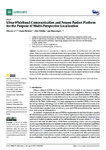Ultra-Wideband Communication and Sensor Fusion Platform for the Purpose of Multi-Perspective Localization.
| dc.contributor.author | Li, C | en |
| dc.contributor.author | Bulman, H | en |
| dc.contributor.author | Whitley, T | en |
| dc.contributor.author | Li, S | en |
| dc.date.accessioned | 2022-10-31T14:08:34Z | |
| dc.date.issued | 2022-09-12 | en |
| dc.identifier.uri | http://hdl.handle.net/10026.1/19799 | |
| dc.description.abstract |
Localization is a keystone for a robot to work within its environment and with other robots. There have been many methods used to solve this problem. This paper deals with the use of beacon-based localization to answer the research question: Can ultra-wideband technology be used to effectively localize a robot with sensor fusion? This paper has developed an innovative solution for creating a sensor fusion platform that uses ultra-wideband communication as a localization method to allow an environment to be perceived and inspected in three dimensions from multiple perspectives simultaneously. A series of contributions have been presented, supported by an in-depth literature review regarding topics in this field of knowledge. The proposed method was then designed, built, and tested successfully in two different environments exceeding its required tolerances. The result of the testing and the ideas formulated throughout the paper were discussed and future work outlined on how to build upon this work in potential academic papers and projects. | en |
| dc.language | eng | en |
| dc.language.iso | eng | en |
| dc.subject | communication | en |
| dc.subject | multi-perspective | en |
| dc.subject | robot localization | en |
| dc.subject | sensor fusion | en |
| dc.subject | ultra-wideband | en |
| dc.subject | Algorithms | en |
| dc.subject | Computer Communication Networks | en |
| dc.title | Ultra-Wideband Communication and Sensor Fusion Platform for the Purpose of Multi-Perspective Localization. | en |
| dc.type | Journal Article | |
| plymouth.author-url | https://www.ncbi.nlm.nih.gov/pubmed/36146229 | en |
| plymouth.issue | 18 | en |
| plymouth.volume | 22 | en |
| plymouth.publication-status | Published online | en |
| plymouth.journal | Sensors (Basel) | en |
| dc.identifier.doi | 10.3390/s22186880 | en |
| plymouth.organisational-group | /Plymouth | |
| plymouth.organisational-group | /Plymouth/Faculty of Science and Engineering | |
| plymouth.organisational-group | /Plymouth/Faculty of Science and Engineering/School of Engineering, Computing and Mathematics | |
| plymouth.organisational-group | /Plymouth/REF 2021 Researchers by UoA | |
| plymouth.organisational-group | /Plymouth/REF 2021 Researchers by UoA/UoA11 Computer Science and Informatics | |
| plymouth.organisational-group | /Plymouth/Users by role | |
| plymouth.organisational-group | /Plymouth/Users by role/Academics | |
| dc.publisher.place | Switzerland | en |
| dcterms.dateAccepted | 2022-09-05 | en |
| dc.rights.embargodate | 9999-12-31 | |
| dc.identifier.eissn | 1424-8220 | en |
| dc.rights.embargoperiod | Not known | en |
| rioxxterms.versionofrecord | 10.3390/s22186880 | en |
| rioxxterms.licenseref.uri | http://www.rioxx.net/licenses/all-rights-reserved | en |
| rioxxterms.licenseref.startdate | 2022-09-12 | en |
| rioxxterms.type | Journal Article/Review | en |


